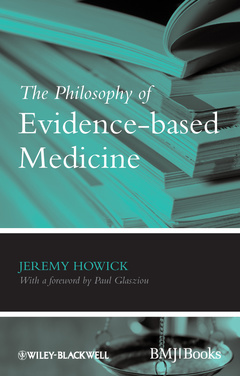The Philosophy of Evidence-based Medicine
Auteur : Howick Jeremy H.

Foreword.
Preface.
Part I: Introduction.
1The philosophy of evidence-based medicine.
1.1 What on earth was medicine based on before evidence-based medicine?
1.2 Scope of the book.
1.3 How the claims of EBM will be examined.
1.4 Structure of what is to come.
2What is EBM?
2.1 EBM as a self-proclaimed Kuhnian paradigm.
2.2 The motivation for the birth of EBM: a sketch.
2.3 Original definition of EBM.
2.4 Reaction to criticism of the EBM system of evidence: more subtle, more or less the same.
3What is good evidence for a clinical decision?
3.1 Introduction.
3.2 Evidence for clinical effectiveness.
3.3 Strong evidence tells us what?
Part II: Do randomization, double masking, and placebo controls rule out more confounding factors than their alternatives?
4Ruling out plausible rival hypotheses and confounding factors: a method.
5 Resolving the paradox of effectiveness: when do observational studies offer the same degree of evidential support as randomized trials?
5.1 The paradox of effectiveness.
5.2 Observational studies: defi nition and problems.
5.3 Randomized trials to the rescue.
5.4 Defending the EBM view that randomized trials provide better evidence than observational studies.
5.5 Overcoming the paradox of effectiveness.
5.6 Conclusion: a more subtle way to distinguish between high- and low-quality comparative clinical studies.
Appendix 1: types of restricted randomization.
Appendix 2: Worrall’s arguments that randomization is required for classical hypothesis testing and establishing probabilistic causes.
6Questioning double blinding as a universal methodological virtue of clinical trials: resolving the Philip's paradox.
6.1 The problems with double masking as a requirement for clinical trial validity.
6.2 The many faces of double masking: clarifying the terminology.
6.3 Confounders that arise from participant and caregiver knowledge.
6.4 The importance of successful double masking.
6.5 One (and a half) solutions to the Philip's paradox.
6.6 The full solution to the Philip's paradox: challenging the view that double masking rules out confounding factors when treatments are evidently dramatic.
6.7 Double masking is valuable unless the treatment effects are evidently dramatic, hence the Philip’s paradox does not arise.
7Placebo controls: problematic and misleading baseline measures of effectiveness.
7.1 The need to control the placebo.
7.2 Legitimate placebo controls.
7.3 How placebo controls often violate the fi rst condition for legitimacy.
7.4 How placebo controls often violate the second condition for legitimacy.
7.5 Special problem for constructing placebos for complex treatments: case studies of exercise and acupuncture.
7.6 Summary and solution to the problem with illegitimate placebo controls.
8Questioning the methodological superiority of "placebo" over "active" controlled trials.
8.1 Epistemological foundations of the ethical debate over the use of placebo-controlled trials.
8.2 Problems with the assay sensitivity arguments against ACTs.
8.3 Problems with the fi rst assay sensitivity argument against ACTs.
8.4 The second assay sensitivity argument.
8.5 Challenging the view that PCTs provide a measure of absolute effect size.
8.6 Questioning the claim that PCTs require smaller sample sizes.
8.7 Conclusion: a reassessment of the relative methodological quality of PCTs.
Appendix: more detailed explanation of why the second assay sensitivity argument fails.
Part III: Examining the paradox that traditional roles for mechanistic reasoning and expert judgment have been up-ended by EBM.
9 Transition to Part III.
9.1 Summary of Part II.
9.2 Introduction to Part III.
10A qualifi ed defence of the EBM stance on mechanistic reasoning.
10.1 A tension between proponents of mechanistic reasoning and EBM views.
10.2 Clarifying the terminology: comparative clinical studies, mechanisms, and mechanistic reasoning.
10.3 Why the strong view that mechanistic reasoning is necessary to establish causal claims is mistaken.
10.4 Two epistemological problems with mechanistic reasoning.
10.5 Why EBM proponents should allow a more prominent role for high-quality (valid and based on "complete" mechanisms) mechanistic reasoning in their evidence hierarchies.
10.6 Mechanisms and other roles in clinical medicine.
10.7 Recommending a (slightly) more important role for mechanistic reasoning in the EBM system.
Appendix: cases where mechanistic reasoning led to the adoption of therapies that were either useless or harmful according to well-conducted clinical research.
11 Knowledge that versus knowledge how: situating the EBM position on expert clinical judgment.
11.1 Controversies surrounding the EBM stance on expert clinical judgement.
11.2 General clinical judgment belongs at the bottom of (or off) the hierarchy of evidence.
11.3 Individual clinical judgment also belongs at the bottom of the hierarchy.
11.4 The equally important non-evidential roles of expertise.
11.5 Conclusion.
Part IV: Conclusions.
12 Moving EBM forward.
12.1 Summary of fi ndings: the EBM philosophy is acceptable, but. . ..
12.2 Two new frontiers for EBM.
References.
Index.
Centre for Evidence-Based Medicine, Department of Primary Care, University of Oxford, UK
Date de parution : 04-2011
Ouvrage de 244 p.
14x21.6 cm
